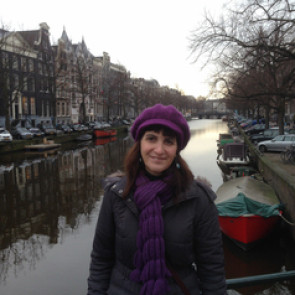
Dr Angeliki Lymberopoulou
Senior Lecturer In Art History
Biography
 Professional biography
Professional biography
BA, Diploma, MA, Art History (Courtauld Institute of Art), Ph.D, Byzantine Art (University of Birmingham)
Angeliki Lymberopoulou joined The Open University in April 2004 from the National Gallery in London, where she worked across the collections as a Dossiers Assistant. She has also taught Modern Greek language and culture at the Foreign & Commonwealth Office, and Byzantine art and architecture at the University of Birmingham. She was the Chair of the Publication Committee of the Society for the Promotion of Byzantine Studies (SPBS) between 2018 and 2024.
Research interests
Byzantine icons and iconography lie at the core of Angeliki's research interests. More specifically, her research focuses on all aspects of artistic production on Venetian Crete (1211-1669) within the social context of cross-cultural interaction between the Byzantine East and the (mainly Italian) West. While Byzantine art is associated predominantly with imperial and aristocratic commissions, Angeliki's research provides a 'voice' for the lower working classes, their representation in the Medieval and Renaissance markets, their religious concerns regarding the afterlife, and the engagement of their senses with the visuality of their commissions.
Research Projects
Above: Angeliki and Miljana in the Serbian Orthodox Church Museum in Belgrade with an icon of the Virgin and Child with Saint Nicholas and young Saint John the Baptist, 15th century (tempera on wood with gold leaf; 30.3 x 22.2 x 0.4 cm)
Angeliki is currently working on a research project with Dr Miljana Matić, curator of icons in the Serbian Orthodox Church Museum in Belgrade, aiming at producing a complete catalogue of the museum's Greek icons. Some of the icons were brought to the Museum from the Fruška Gora Monasteries after World War II, others originated from the Chapel of Saint Sava in Constantinople and a number were donated to the Museum by private individuals, but in their majority, these icons remain unpublished. While Angeliki and Miljana continue working towards the production of the catalogue, they have accepted an invitation by the prestigious Serbian periodical Zograf to publish one of the icons in the Museum’s collection, a Madre della Consolazione. This particular icon is one of the best surviving examples of the post-Byzantine type of the Virgin and Child which features among Angeliki’s and Miljana’s main research interests; they are both honoured and delighted with this opportunity to showcase their research project and forthcoming catalogue. Angeliki and Miljana are grateful to the Musuem's Director, priest Dr Vladimir Radovanović, and to the Museum’s staff for their generous assistance, as well as to The Open University for its generous financial support and for facilitating Angeliki’s visits to Belgrade so she can work together with Miljana on the icons in situ.
Teaching interests
Angeliki was Director of Teaching (2012-2016) and Qualification Lead (2016-2020) for the department of Art History and currently serves as Employability Lead for the Scool of Arts and Humanities.
Teaching contributions in art history modules (both in production and presentation) include: The Art History Residential School (AXR272); Art and Visual Culture (A226); Art and Life before 1800 (A237); Renaissance Art Reconsidered (AA315); and The MA in Art History (A843 & A844).
She also taught the following modules in presentation: The Arts Past and Present (AA100); Art and its Histories (A216); Understanding Global Heritage (AD281); Art, Society and Religion in Siena, Florence and Padua 1280-1400 (A354); and Display and Devotion. Religious Painting in Italy 1300-1500 (A424).
Publications
Book
Byzantine Art and Renaissance Europe (2013)
Art and Visual Culture: A Reader (2012)
Book Chapter
Maniera Greca and Renaissance Europe: More than Meets the Eye (2023)
Domenikos Theotokopoulos and Ancient Greek Art (2019)
Sight and the Byzantine Icon (2018)
Regional Byzantine Monumental Art from Venetian Crete (2013)
The Noli Me Tangere icon at the British Museum: vision, message and reality (2011)
Exhibition / Performance
Heavenly Beings: Icons of the Orthodox Christian World (2022)
Journal Article
Post-Byzantine Cretan Icon Painting: Demand and Supply Revisited (2023)
The five senses in Hell (2020)
Sight and the Byzantine Icon (2018)
The Noli me Tangere: study and conservation of a Cretan icon (2011)
A Winged Saint John the Baptist icon in the British Museum (2003)
Other
Presentation / Conference
Representations of Donors in Monumental Art of Venetian Crete (2020)
Palaiologan art from regional Crete: Artistic decline or social progress? (2019)